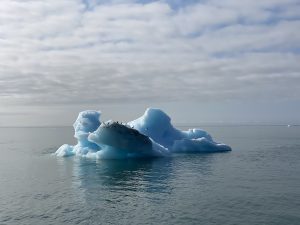 When I heard the name Valdez, I immediately used to think about the disastrous Exxon Valdez oil spill in 1989. I remember very well watching the TV news as a 10-year old and being absolutely shocked by the images of the sea birds and otters covered in oil. Now, almost 25 years later, on the surface it is hard to still see traces of this eco disaster. But you only need to dig 30 cm on the beaches to find traces of oil of the spill. Certain animal population numbers have still not recovered. Some will never recover again as we would find out during our visit. All that being said, these days, Valdez and the nearby Prince William Sound are absolutely stunning. Going forward we will no longer automatically associate the town with the oil spill but rather think about the amazing time we had there.
When I heard the name Valdez, I immediately used to think about the disastrous Exxon Valdez oil spill in 1989. I remember very well watching the TV news as a 10-year old and being absolutely shocked by the images of the sea birds and otters covered in oil. Now, almost 25 years later, on the surface it is hard to still see traces of this eco disaster. But you only need to dig 30 cm on the beaches to find traces of oil of the spill. Certain animal population numbers have still not recovered. Some will never recover again as we would find out during our visit. All that being said, these days, Valdez and the nearby Prince William Sound are absolutely stunning. Going forward we will no longer automatically associate the town with the oil spill but rather think about the amazing time we had there.
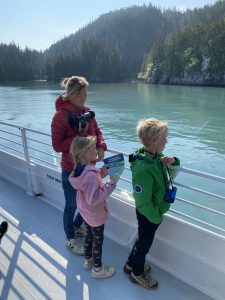 You really can’t go to Alaska and not go on a boat trip through the fjords and get close to a maritime glacier. So we went looking for an opportunity to cruise the fjords AND spot some wildlife. Again through our Dutch ‘virtual’ friends, we heard about the cruises to Meares Glacier. It will probably turn out to be one of the most expensive days of our trip, but the cruise was so worth it. We timed the trip nicely within a ‘good weather’ window, so now we only had to keep our fingers crossed that some animals showed up.
You really can’t go to Alaska and not go on a boat trip through the fjords and get close to a maritime glacier. So we went looking for an opportunity to cruise the fjords AND spot some wildlife. Again through our Dutch ‘virtual’ friends, we heard about the cruises to Meares Glacier. It will probably turn out to be one of the most expensive days of our trip, but the cruise was so worth it. We timed the trip nicely within a ‘good weather’ window, so now we only had to keep our fingers crossed that some animals showed up.
While we were leaving the harbor, the skipper/guide was giving some orientation and we found out that we had been sleeping right at the epi center of the 1969 Good Friday earthquake. One of the biggest earthquakes ever recorded, actually ‘liquified’ the foundations of the old city and on top of that, caused a massive tsunami that swept away whatever was still standing or alive.
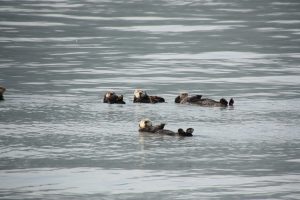 Just outside the harbor we came across the first animals: a raft of sea otters. It’s hard to imagine something more cute than a bunch of these creatures, chilling on their back in the sea. The next animals we came across were very high on the kids’ wishlist: Orca!
Just outside the harbor we came across the first animals: a raft of sea otters. It’s hard to imagine something more cute than a bunch of these creatures, chilling on their back in the sea. The next animals we came across were very high on the kids’ wishlist: Orca!
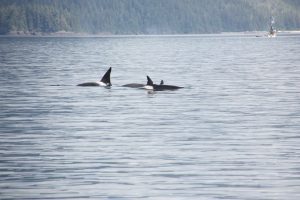 The story of the pod of orca that we came across was rather shocking though. They had been seen swimming right into the oil spill back in 1989. The losses were terrible. None of the fertile females survived. For almost 25 years now this Orca family has been swimming around on their way to extinction. Every year the family gets smaller and the 3 Orca we saw, were about all that is left of what was once one of the biggest Orca families in the Northern seas.
The story of the pod of orca that we came across was rather shocking though. They had been seen swimming right into the oil spill back in 1989. The losses were terrible. None of the fertile females survived. For almost 25 years now this Orca family has been swimming around on their way to extinction. Every year the family gets smaller and the 3 Orca we saw, were about all that is left of what was once one of the biggest Orca families in the Northern seas.
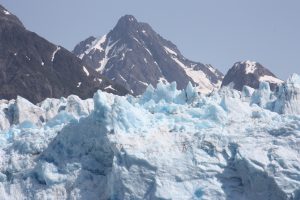 We continued our sailing through the gorgeous fjords to the Meares Glacier, carefully avoiding the massive ice bergs that calved off the different glaciers. Meares glacier is the only maritime glacier in Alaska that is still advancing .Watching and hearing the glacier advance in front of us was very impressive. Pushing large ice bergs into the sea, while tearing down the trees at the side of the valley.
We continued our sailing through the gorgeous fjords to the Meares Glacier, carefully avoiding the massive ice bergs that calved off the different glaciers. Meares glacier is the only maritime glacier in Alaska that is still advancing .Watching and hearing the glacier advance in front of us was very impressive. Pushing large ice bergs into the sea, while tearing down the trees at the side of the valley.
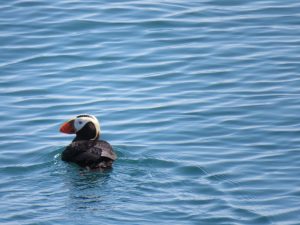 On the way back there was a nice surprise for Caro and myself, when we came across a bunch of puffins. We had been a bit sad when we just missed these beautiful birds in Iceland many years ago. This time we even got to see two different species. Before reaching Valdez there were also dolphins and a sealion colony. “The best day of our trip” according to the kids. Spoiler alert: there would be more ‘best days of the trip’ in Alaska.
On the way back there was a nice surprise for Caro and myself, when we came across a bunch of puffins. We had been a bit sad when we just missed these beautiful birds in Iceland many years ago. This time we even got to see two different species. Before reaching Valdez there were also dolphins and a sealion colony. “The best day of our trip” according to the kids. Spoiler alert: there would be more ‘best days of the trip’ in Alaska.
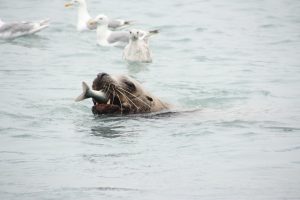 Before leaving Valdez, we visited a salmon hatchery where, after a couple of years at sea, thousands of Salmon, returned to the river where they were born to lay their eggs (spawn) and die. Some of them don’t make it to the river because a couple of predators are hanging around for ‘their all you can eat buffet of the summer’. Grizzly bears are big fans of the salmon but while we were there it was the Sealions that were feasting.
Before leaving Valdez, we visited a salmon hatchery where, after a couple of years at sea, thousands of Salmon, returned to the river where they were born to lay their eggs (spawn) and die. Some of them don’t make it to the river because a couple of predators are hanging around for ‘their all you can eat buffet of the summer’. Grizzly bears are big fans of the salmon but while we were there it was the Sealions that were feasting.
From Valdez we went to Wrangell St Elias NP, one of the biggest national parks in the US. Only a small part of the park can be reached more or less easy. In Alaska terms, that means via a 90 km gravel road on what used to be the railway to the copper mines. Another bumpy ride with as an additional challenge, trying to avoid old railway spikes sticking out.
The small part of the park that we visited, the McCharty/Kennecot area, is dominated by 3 truly massive glaciers We had planned to stay only one night but ended up staying three days. The weather was fantastic again. For us that is. Because this weather was not normal at all. It was way too hot and the glaciers were melting faster than ever.
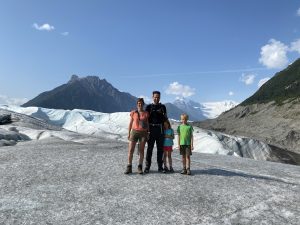 On our first afternoon we went on, what we thought was a short hike to one of the glaciers. It turned out to be quite a bit longer than we expected but we did make it to the ice at the foot of the glacier. Since we didn’t have any material (crampons, ropes) or guide with us, we did not venture far on to the glacier.
On our first afternoon we went on, what we thought was a short hike to one of the glaciers. It turned out to be quite a bit longer than we expected but we did make it to the ice at the foot of the glacier. Since we didn’t have any material (crampons, ropes) or guide with us, we did not venture far on to the glacier.
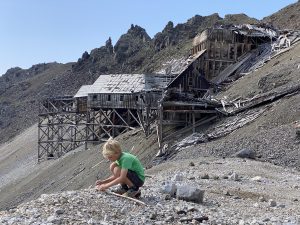 The next day we wanted to check out some of the mining history of the Kennecot Copper mine. In the town of Kennecot, the old buildings of the mine have been carefully restored. These buildings are the residential areas, the train station and a ‘concentration mill’. To visit the mines, you need to go up into the mountains. Pretty high into the mountains as we experienced. This was probably our toughest hike so far. But it was amazing to get up to the Bonanza mines. Or what is left of the mine. These buildings have not been restored and are completely dilapidated. The whole area was abandoned in just one day in 1938, when the company announced they would close all the mines and everybody needed to be on the last train out the next evening. Literally everything was abandoned as it was. And even though the mine sites have served as Alaska’s biggest outdoor and free ‘DIY shop’ for years, there is still a lot of the gear left that was used for mining. And the mountain is still full of copper ore that is lying at the surface, ready to be mined, giving it a bizarre green/blue color.
The next day we wanted to check out some of the mining history of the Kennecot Copper mine. In the town of Kennecot, the old buildings of the mine have been carefully restored. These buildings are the residential areas, the train station and a ‘concentration mill’. To visit the mines, you need to go up into the mountains. Pretty high into the mountains as we experienced. This was probably our toughest hike so far. But it was amazing to get up to the Bonanza mines. Or what is left of the mine. These buildings have not been restored and are completely dilapidated. The whole area was abandoned in just one day in 1938, when the company announced they would close all the mines and everybody needed to be on the last train out the next evening. Literally everything was abandoned as it was. And even though the mine sites have served as Alaska’s biggest outdoor and free ‘DIY shop’ for years, there is still a lot of the gear left that was used for mining. And the mountain is still full of copper ore that is lying at the surface, ready to be mined, giving it a bizarre green/blue color.
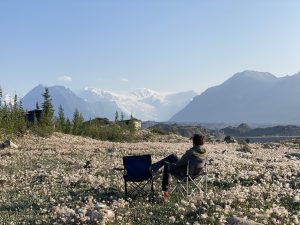 After the hike we also visited the town of McCharty. Linked to the mine, it was completely abandoned in 1938 and turned into a ghost town until the 1970’s when a mix of young adventurous people, artists and weirdos started to restore buildings and created a new community in the middle of nowhere. These days is a lively community with a lot of the 1970’s people still living there. We really liked the hippie/trapper/independent/laidback vibe. And we really appreciated that we could use their communal swimming pond to cool off after the very hot hike.
After the hike we also visited the town of McCharty. Linked to the mine, it was completely abandoned in 1938 and turned into a ghost town until the 1970’s when a mix of young adventurous people, artists and weirdos started to restore buildings and created a new community in the middle of nowhere. These days is a lively community with a lot of the 1970’s people still living there. We really liked the hippie/trapper/independent/laidback vibe. And we really appreciated that we could use their communal swimming pond to cool off after the very hot hike.
We stuck around another day to enjoy the incredible views and relax. And while I was swimming with the kids, Caro got surprised by a black bear that came to visit our camp spot. Luckily the bear was just as surprised and scared and quickly took off.
There was however something else we needed to do on our rest day: decide on how to get to Vancouver by mid August where some friends would visit us:
- The first option was to take it easy and take the Alaska Highway straight to British Colombia.
- The second option was to visit the South East region of Alaska. That would mean however that it was going to be a race to get to Vancouver in time.
In the end ‘FOMO’ (fear of missing out) got the best of us and we decided for option 2.
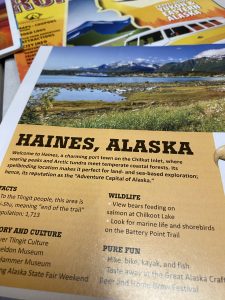 To get to South Eastern Alaska, we needed to drive through Canada for a day. And what a beautiful drive it was; through Kluane National Park and on to the Haines Highway. This highway was one of the main reasons to make the Alaska detour, together with the possibility to visit the historic town of Skagway. However on our way to Haines, we stopped to do laundry and there we read (in an 3 year old magazine) about the opportunity to see Grizzly bears fish for Salmon We hadn’t heard about this in any of the travel guides so we decided to ask around when we got to Haines.
To get to South Eastern Alaska, we needed to drive through Canada for a day. And what a beautiful drive it was; through Kluane National Park and on to the Haines Highway. This highway was one of the main reasons to make the Alaska detour, together with the possibility to visit the historic town of Skagway. However on our way to Haines, we stopped to do laundry and there we read (in an 3 year old magazine) about the opportunity to see Grizzly bears fish for Salmon We hadn’t heard about this in any of the travel guides so we decided to ask around when we got to Haines.
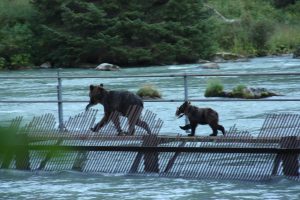 After another (it’s getting boring) incredibly scenic hike to a viewpoint of the fjords around Haines, we went to the local tourist office. There they confirmed that we could try to see bears at the Fish weir (a metal construction built to count and help salmon in the spawning process). When we got there, the place was full of fisherman and two or three photographers. We got confirmation that a day before a Grizzly mom with two cubs had been seen. We found a parking spot right next to the viewing platform. While we waited we had time to clean the van, do homeschooling cook and eat dinner. But after 3 hours of waiting and when we were about to give up (Lucie already went to bed), suddenly we heard that a mom and cubs were on the way. And surely a couple of minutes later we saw a Grizzly on the other side of the river.
After another (it’s getting boring) incredibly scenic hike to a viewpoint of the fjords around Haines, we went to the local tourist office. There they confirmed that we could try to see bears at the Fish weir (a metal construction built to count and help salmon in the spawning process). When we got there, the place was full of fisherman and two or three photographers. We got confirmation that a day before a Grizzly mom with two cubs had been seen. We found a parking spot right next to the viewing platform. While we waited we had time to clean the van, do homeschooling cook and eat dinner. But after 3 hours of waiting and when we were about to give up (Lucie already went to bed), suddenly we heard that a mom and cubs were on the way. And surely a couple of minutes later we saw a Grizzly on the other side of the river.
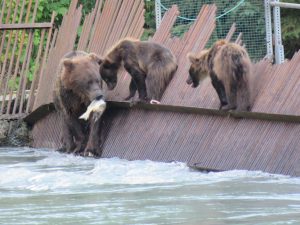
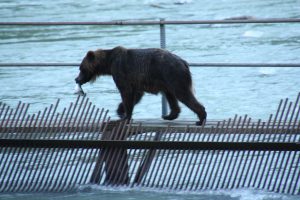 While she got on the metal construction to start fishing we saw two cubs come out of the bushes, followed by a third one. For about an hour we got a masterclass in fishing and fish filleting from the Grizzly mom and cubs! And then they disappeared in the woods. And while all of us on the platform were waiting and hoping she would come back for some more, we heard someone yell: ”another grizzly is coming, get to your vehicles!” Just seconds later another Grizzly climbed onto the platform where we had been standing, followed by two more cubs. And the whole show started again! We found tout hat the cubs of both Grizzly moms had been born this year but it was interesting to see that the cubs of the first bear could already fish for themselves while the cubs of the second mom were still fully dependent on their mother. We also found out that this second mom had pulled a couple of stunts before; surprising everybody and being in the middle of the crowd all of a sudden and sending everybody running in all directions. And we got to see a little of that when she was finished feeding. By now half the town was at the site and on her exit the grizzly mom did a mock charge to the people on the road to make place for her and the cubs to get into the bush. Again she sent everybody running for cover. An interesting end to the most memorable evening on our trip so far.
While she got on the metal construction to start fishing we saw two cubs come out of the bushes, followed by a third one. For about an hour we got a masterclass in fishing and fish filleting from the Grizzly mom and cubs! And then they disappeared in the woods. And while all of us on the platform were waiting and hoping she would come back for some more, we heard someone yell: ”another grizzly is coming, get to your vehicles!” Just seconds later another Grizzly climbed onto the platform where we had been standing, followed by two more cubs. And the whole show started again! We found tout hat the cubs of both Grizzly moms had been born this year but it was interesting to see that the cubs of the first bear could already fish for themselves while the cubs of the second mom were still fully dependent on their mother. We also found out that this second mom had pulled a couple of stunts before; surprising everybody and being in the middle of the crowd all of a sudden and sending everybody running in all directions. And we got to see a little of that when she was finished feeding. By now half the town was at the site and on her exit the grizzly mom did a mock charge to the people on the road to make place for her and the cubs to get into the bush. Again she sent everybody running for cover. An interesting end to the most memorable evening on our trip so far.
The next day we hopped on a ferry to Skagway, the historic port where most of the gold seekers had arrived for the Goldrush that we talked about in the previous blog. The town had exploded in a couple of months and then just as quickly turned in a ghost town when the gold rush was over. A real ‘boom to bust’ town.
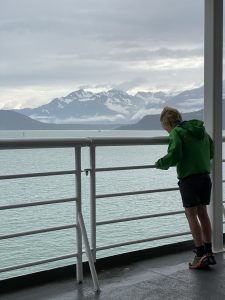 We had been warned that the town got really over run by cruise ships tourists. We had a hard time believing this after all the tranquility we experienced all over Alaska. But when our decent size ferry arrived in the harbor it was completely dwarfed by three of the biggest cruise ships we ever saw. While we were offboarding from the ferry, the ships were ready to depart and so like salmon against the stream we drove the van through hundreds of people getting back to their ships. By the time we had parked the van, the town was nearly completely empty.
We had been warned that the town got really over run by cruise ships tourists. We had a hard time believing this after all the tranquility we experienced all over Alaska. But when our decent size ferry arrived in the harbor it was completely dwarfed by three of the biggest cruise ships we ever saw. While we were offboarding from the ferry, the ships were ready to depart and so like salmon against the stream we drove the van through hundreds of people getting back to their ships. By the time we had parked the van, the town was nearly completely empty.
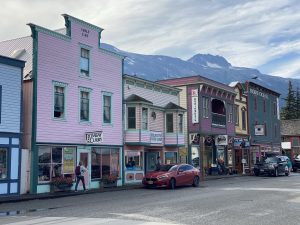 We appreciated the historic buildings and the interesting movie at the visitor center. However with all the ‘tourist trap’ shops/shows/etc, it did not feel a bit as authentic as Dawson City (the final destination of the gold rush that we visited a month earlier). It was interesting to see however, how the town is now revisiting its ‘boomtown to ghost town’ history on a daily basis thanks to the cruise ships.
We appreciated the historic buildings and the interesting movie at the visitor center. However with all the ‘tourist trap’ shops/shows/etc, it did not feel a bit as authentic as Dawson City (the final destination of the gold rush that we visited a month earlier). It was interesting to see however, how the town is now revisiting its ‘boomtown to ghost town’ history on a daily basis thanks to the cruise ships.
This was our last day in Alaska and for the first time it rained for a couple of hours. Remember we had been expecting rain 70% of the time. And although we are very aware that this is not normal and has terrible consequences (wildfires everywhere), we felt really grateful for this amazing month we had in Alaska. As we drove out of the fjord to the pass and border with Canada we looked back once more and then said or final goodbyes to Alaska…or maybe not that final…

Ongelooflijk; weer helemaal meebeleefd….
👍
Dankjewel voor alweer zo’n heerlijke portie leesvoer op een regenachtige zondagmorgen 👌😘
❤️